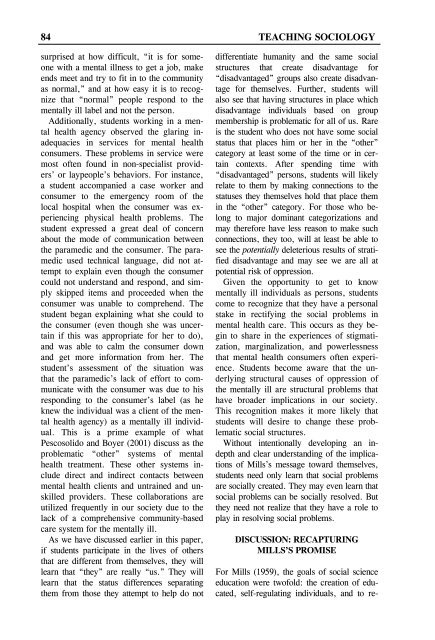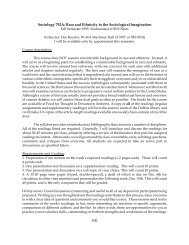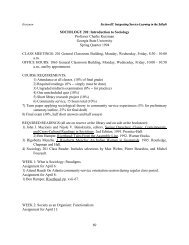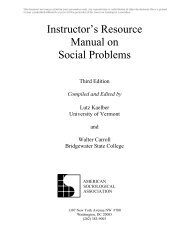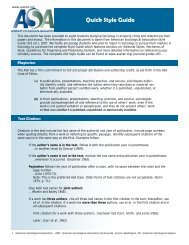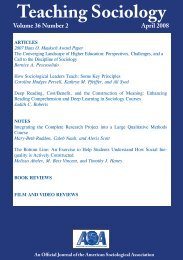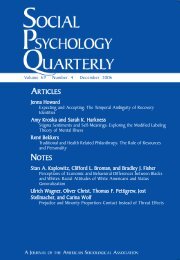Teaching Sociology - American Sociological Association
Teaching Sociology - American Sociological Association
Teaching Sociology - American Sociological Association
Create successful ePaper yourself
Turn your PDF publications into a flip-book with our unique Google optimized e-Paper software.
84 TEACHING SOCIOLOGY<br />
surprised at how difficult, “it is for someone<br />
with a mental illness to get a job, make<br />
ends meet and try to fit in to the community<br />
as normal,” and at how easy it is to recognize<br />
that “normal” people respond to the<br />
mentally ill label and not the person.<br />
Additionally, students working in a mental<br />
health agency observed the glaring inadequacies<br />
in services for mental health<br />
consumers. These problems in service were<br />
most often found in non-specialist providers’<br />
or laypeople’s behaviors. For instance,<br />
a student accompanied a case worker and<br />
consumer to the emergency room of the<br />
local hospital when the consumer was experiencing<br />
physical health problems. The<br />
student expressed a great deal of concern<br />
about the mode of communication between<br />
the paramedic and the consumer. The paramedic<br />
used technical language, did not attempt<br />
to explain even though the consumer<br />
could not understand and respond, and simply<br />
skipped items and proceeded when the<br />
consumer was unable to comprehend. The<br />
student began explaining what she could to<br />
the consumer (even though she was uncertain<br />
if this was appropriate for her to do),<br />
and was able to calm the consumer down<br />
and get more information from her. The<br />
student’s assessment of the situation was<br />
that the paramedic’s lack of effort to communicate<br />
with the consumer was due to his<br />
responding to the consumer’s label (as he<br />
knew the individual was a client of the mental<br />
health agency) as a mentally ill individual.<br />
This is a prime example of what<br />
Pescosolido and Boyer (2001) discuss as the<br />
problematic “other” systems of mental<br />
health treatment. These other systems include<br />
direct and indirect contacts between<br />
mental health clients and untrained and unskilled<br />
providers. These collaborations are<br />
utilized frequently in our society due to the<br />
lack of a comprehensive community-based<br />
care system for the mentally ill.<br />
As we have discussed earlier in this paper,<br />
if students participate in the lives of others<br />
that are different from themselves, they will<br />
learn that “they” are really “us.” They will<br />
learn that the status differences separating<br />
them from those they attempt to help do not<br />
differentiate humanity and the same social<br />
structures that create disadvantage for<br />
“disadvantaged” groups also create disadvantage<br />
for themselves. Further, students will<br />
also see that having structures in place which<br />
disadvantage individuals based on group<br />
membership is problematic for all of us. Rare<br />
is the student who does not have some social<br />
status that places him or her in the “other”<br />
category at least some of the time or in certain<br />
contexts. After spending time with<br />
“disadvantaged” persons, students will likely<br />
relate to them by making connections to the<br />
statuses they themselves hold that place them<br />
in the “other” category. For those who belong<br />
to major dominant categorizations and<br />
may therefore have less reason to make such<br />
connections, they too, will at least be able to<br />
see the potentially deleterious results of stratified<br />
disadvantage and may see we are all at<br />
potential risk of oppression.<br />
Given the opportunity to get to know<br />
mentally ill individuals as persons, students<br />
come to recognize that they have a personal<br />
stake in rectifying the social problems in<br />
mental health care. This occurs as they begin<br />
to share in the experiences of stigmatization,<br />
marginalization, and powerlessness<br />
that mental health consumers often experience.<br />
Students become aware that the underlying<br />
structural causes of oppression of<br />
the mentally ill are structural problems that<br />
have broader implications in our society.<br />
This recognition makes it more likely that<br />
students will desire to change these problematic<br />
social structures.<br />
Without intentionally developing an indepth<br />
and clear understanding of the implications<br />
of Mills’s message toward themselves,<br />
students need only learn that social problems<br />
are socially created. They may even learn that<br />
social problems can be socially resolved. But<br />
they need not realize that they have a role to<br />
play in resolving social problems.<br />
DISCUSSION: RECAPTURING<br />
MILLS’S PROMISE<br />
For Mills (1959), the goals of social science<br />
education were twofold: the creation of educated,<br />
self-regulating individuals, and to re-


